 To enhance service speed and avoid tariff delays, we've opened a US warehouse. All US orders ship directly from our US facility.
To enhance service speed and avoid tariff delays, we've opened a US warehouse. All US orders ship directly from our US facility.
| Cat. No. | Product Name | Field of Application | Chemical Structure |
|---|---|---|---|
| DC67650 | EB-Lipid |
EB-Lipid is an innovatively engineered ionizable lipid designed to replace conventional PEG-lipid in mRNA vaccine formulations. Its structure comprises three key components: an Evans Blue-derived headgroup with high affinity for albumin, a tetraethylene glycol linker that enhances colloidal stability, and dual oleate tails for anchoring into lipid bilayers. This molecular design enables EB-Lipid to actively recruit endogenous albumin, forming an albumin-rich protein corona on the surface of lipid nanoparticles (LNPs). Following intramuscular administration, these albumin-bound EB-LNPs are preferentially transported through lymphatic vessels rather than entering the bloodstream, thereby avoiding hepatic accumulation and associated hepatotoxicity risks.Experimental data demonstrate that EB-LNPs achieve significantly higher accumulation in lymph nodes, where they are efficiently internalized by dendritic cells via albumin receptor-mediated endocytosis (e.g., gp60). This process enhances antigen presentation and activates robust cellular and humoral immune responses. In both tumor models (B16-OVA and HPV-associated) and infectious disease models (H1N1 and SARS-CoV-2 Omicron), EB-LNP-based mRNA vaccines elicited potent cytotoxic T-cell activation and durable neutralizing antibody production at low doses. Unlike traditional PEG-LNPs, EB-LNPs show minimal liver distribution, reduced immunogenicity, and improved safety profiles after repeated administrations.By leveraging albumin’s natural trafficking pathway, EB-Lipid represents a transformative delivery platform that combines targeted lymph node delivery with enhanced biosafety, positioning it as a promising candidate for next-generation mRNA vaccines and therapeutics.
More description
|

|
| DC67632 | Lipid GL5 |
GL5 is an ionizable guanidine-based lipid nanoparticle (G-LNP) designed for superior mRNA delivery. Its guanidinocarbonyl-pyrrole (GCP) headgroup enables pH-responsive behavior and strong mRNA binding via bidentate hydrogen bonds. The cholesterol-free GL5-3 formulation forms compact, stable nanoparticles (~90-120 nm) that exhibit excellent spleen-targeting capability after intravenous injection.GL5-LNPs efficiently deliver mRNA to antigen-presenting cells (APCs), enhancing antigen presentation and T cell activation. In cancer immunotherapy models, GL5-based mRNA vaccines provided complete tumor protection and induced durable immune memory. The platform also enables mRNA delivery to other organs like the pancreas via different administration routes, demonstrating remarkable versatility and therapeutic potential.
More description
|

|
| DC67633 | Lipid KEL12 |
(4S)-KEL12 is a novel, biodegradable ionizable lipid developed for advanced mRNA vaccine delivery. It was rationally designed by incorporating both a ketal group in the linker and ester segments in the hydrophobic tails, a dual-degradable strategy aimed at enhancing its safety profile. Through iterative optimization, (4S)-KEL12 was identified as a lead candidate with an optimal pKa value of approximately 6.78, which is crucial for efficient mRNA encapsulation and endosomal release.
More description
|
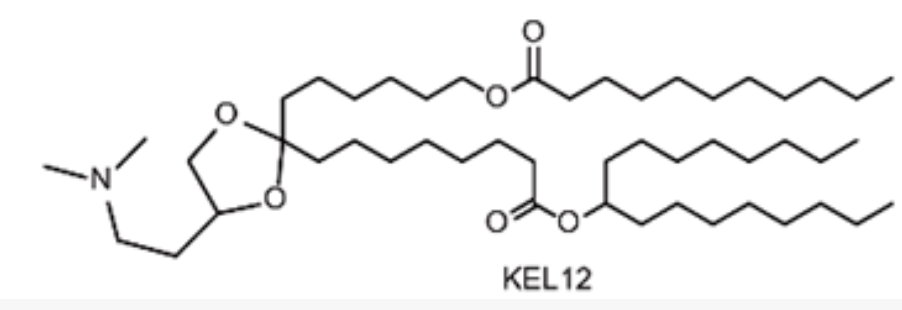
|
| DC60432 | DORI Featured |
DORI, N-(2-hydroxyethyl)-N,N-dimethyl-2,3-bis(oleoyloxy)propan-1-aminium bromide, is an ionizable cationic lipid with lower cytotoxicity and high transfection efficiency. Reagent grade, for research use only.
More description
|

|
| DC60880 | 2Ac3-C18 Featured |
2Ac3-C18 is a unique ionizable lipid with a distinct degradable core structure:featuring 2 acrylate units and 3 amine groups—linked to a C18 alkyl chain. Its LNPs (formulated with DOPE/cholesterol/DMG-PEG2000) exhibit spleen-specific mRNA delivery in vivo.
More description
|

|
| DC60879 | Lipid te AA3-Dlin Featured |
Lipid te AA3-Dlin is a novel ionizable lipid developed for mRNA-LNP vaccines.When formulated into LNPs, te AA3-Dlin demonstrates excellent stability in serum and protects encapsulated mRNA from degradation. A key feature is its unique protein corona profile, with high ApoE abundance, which is crucial for efficient in vivo targeting, particularly to the spleen. This enables potent dendritic cell transfection, leading to enhanced antigen presentation and robust cytotoxic T-cell responses for superior antitumor immunity.
More description
|
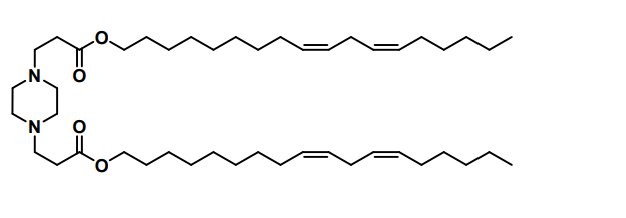
|
| DC86070 | 304-O13 Featured |
304O13 is a novel Biodegradable lipidoid for RNA delivery.
More description
|

|
| DC60848 | Lipid 854 Featured |
Lipid 854 is an ionizable cationic lipid that has been used in the generation of lipid nanoparticles (LNPs) for the delivery of mRNA in vivo. Lipid 854 has been optimized based on Lipid 88.
More description
|
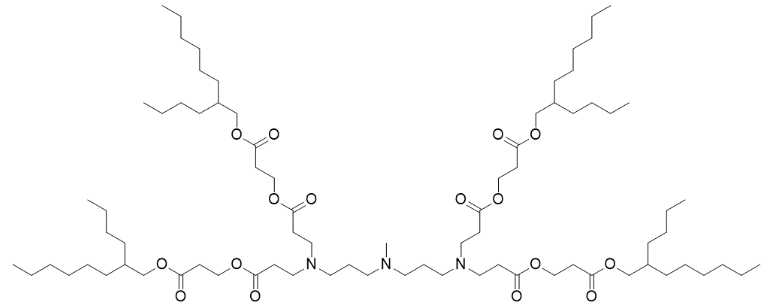
|
| DC67567 | ARV-T1 Featured |
ARV-T1 is a novel ionizable lipid featuring a cholesterol moiety incorporated in its tail, designed to enhance mRNA delivery efficiency. With a pKa of 6.73, it exhibits optimal pH-dependent ionization for endosomal escape and mRNA release. Structurally, ARV-T1 contains a tertiary amine head group and ester-linked lipid tails, enabling rapid in vivo metabolism and improved biocompatibility.Compared to SM-102 (used in Moderna's vaccine), LNPs formulated with ARV-T1 demonstrate superior physicochemical properties: smaller particle size (~80 nm vs. 90 nm), lower polydispersity index (0.09 vs. 0.10), and higher absolute zeta potential (-10 mV vs. -5 mV). These characteristics correlate with >90% mRNA encapsulation efficiency and enhanced stability, maintaining performance for 12 weeks at -20°C.In vitro, ARV-T1 LNPs showed 7-fold higher protein expression than SM-102 LNPs. In vivo, they prolonged luciferase expression (>72 hours vs. <48 hours for SM-102) and induced 10-fold higher neutralizing antibodies against SARS-CoV-2 spike protein at low doses. The cholesterol tail promotes endosomal membrane fusion, while ester linkages facilitate metabolic clearance, yielding an excellent safety profile in toxicity studies. This combination of efficacy and safety positions ARV-T1 as a promising platform for mRNA vaccines and therapeutics.
More description
|
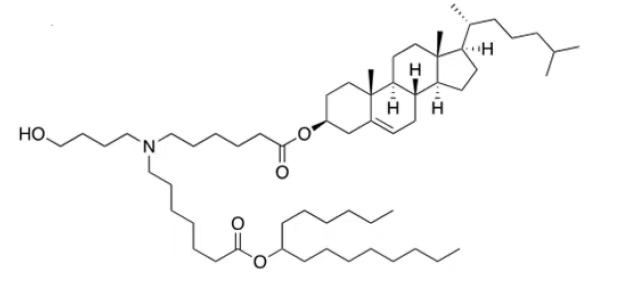
|
| DC67605 | PyCB lipid Featured |
The PyCB (Pyridine Carboxybetaine) lipid is a rationally designed zwitterionic ionizable lipid that serves as a core functional component in the novel three-component (ThrCo) lipid nanoparticle (LNP) platform. It is synthesized by covalently attaching a zwitterionic PyCB structure to the hydroxyl group of the clinically available ionizable lipid ALC-0315.Its key feature is its pH-responsive behavior. At physiological pH (~7.4), the PyCB headgroup exhibits zwitterionic properties, forming charge-assisted hydrogen bonds with water molecules (PyCB-H₂O complexes). This confers high hydrophilicity to the LNP surface, enhancing stability in aqueous environments and reducing nonspecific protein adsorption in the bloodstream. This zwitterionic surface effectively mimics and replaces PEGylated lipids, thereby avoiding PEG immunogenicity and the associated Accelerated Blood Clearance (ABC) effect upon repeated administrations.Crucially, in the acidic environment of endosomes (pH ~6.5), the PyCB group undergoes strong protonation, rapidly transforming into a cationic state (PyCB-H₃O⁺ complexes). This promotes efficient fusion with and disruption of the endosomal membrane, facilitating the escape and cytoplasmic release of encapsulated mRNA.By replacing both cholesterol and PEGylated lipids in traditional LNPs, PyCB lipid enables the redirection of LNP biodistribution from the liver to the spleen, achieving superior spleen-specific mRNA translation and enhancing antigen presentation for potent immune activation.
More description
|
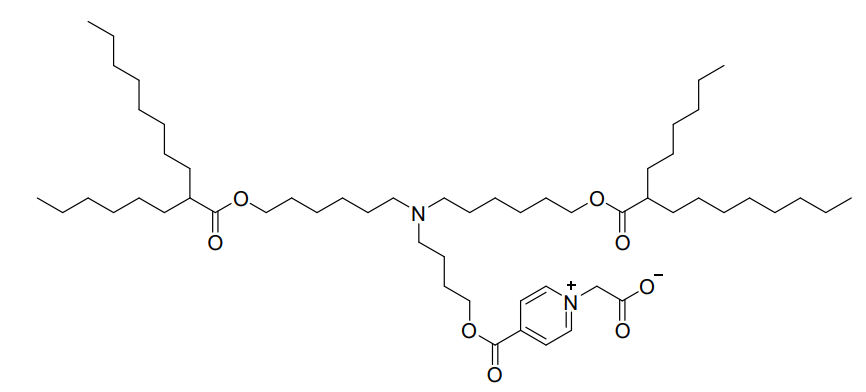
|
| DC60878 | Lipid A-12 Featured |
Lipid A-12 is an ionizable cationic lipid from Capstan Therapeutics and a close analog of CICL-1 (L829). The key structural distinction is in the headgroup spacer length, where the value of 'n' is 1 in A-12, compared to 0 in CICL-1 (L829).
More description
|
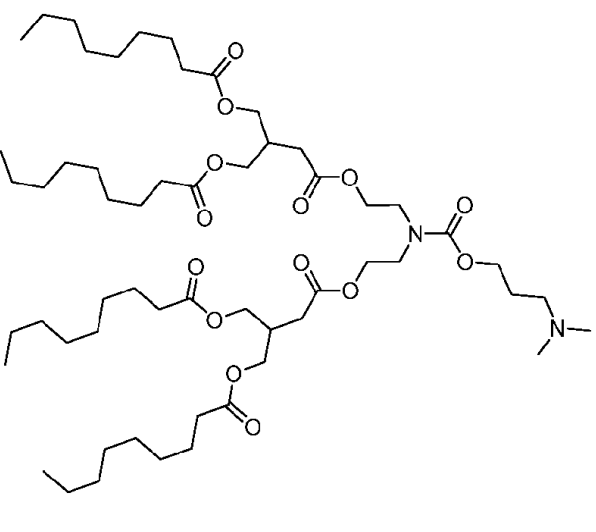
|
| DC71687 | Dlin-MeOH Featured |
Dlin-MeOH is a lipid product for use in drug delivery systems.
More description
|

|
| DC60537 | C18 NC-TNP Featured |
NC-TNP (noncationic thiourea lipids nanoparticles) could compress mRNA by strong hydrogen bonds interaction between thiourea groups of NC-TNP and the phosphate groups of mRNA. NC-TNP could escape the recycling pathway to inhibit the egress of internalized nanoparticles from the intracellular compartment to the extracellular milieu. NC-TNP-encapsulated mRNA shows higher gene transfection efficiency in vitro and in vivo than mRNA-LNP formulation. NC-TNP also shows spleen targeting delivery ability with higher accumulation ratio (spleen/liver), compared with traditional LNP.The C18 non-cationic thiourea lipid self-assembles into ~100 nm nanoparticles with neutral surface charge, utilizing strong hydrogen bonding between its thiourea groups and mRNA phosphate groups for efficient mRNA complexation. This delivery system demonstrates significantly enhanced EGFP expression efficiency—2.3-fold higher than standard C6/C12 formulations—in DC2.4, B16, and 4T1 cells, while sustaining luciferase activity for over 20 days post-subcutaneous injection. It exhibits exceptional stability, maintaining >94% mRNA integrity and <10% particle size variation after 30-day lyophilized storage. Importantly, the nanoparticles show pronounced spleen-targeting capability with 20-fold greater accumulation in the spleen versus liver, effectively activating twice the level of antigen-specific CD8⁺ T cells. Critically, the system avoids cationic lipid-associated toxicity, inducing no detectable IL-6/CXCL10 inflammation and causing no histopathological damage in cardiac or splenic tissues, thus establishing a novel high-efficacy, low-toxicity mRNA delivery platform.
More description
|
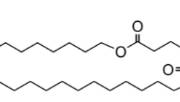
|
| DC67602 | ILB-3132(E12LA6B603) Featured |
E12LA6B603(ILB3132,ILB-3132) is a novel ionizable amino lipid disclosed in patent WO2024198497A1, developed by MagicRNA, representing a highly efficient component for lipid nanoparticle (LNP) delivery systems.When formulated into LNPs, E12LA6B603 LNP achieves a remarkable 98.26% encapsulation efficiency for mRNA. It mediates superior in vitro transfection in dendritic cells (1.8E+05 intensity) and demonstrates best-in-class in vivo protein expression after intramuscular injection (2.2E+09 intensity). Most notably, in a B16-OVA melanoma model, therapeutic OVA-mRNA vaccines delivered by E12LA6B603 LNPs induced 100% complete tumor regression, highlighting its superior efficacy over benchmarks like DLin-MC3 and SM-102. Its biodegradable ester linkages and balanced structure make it a promising, potent candidate for next-generation mRNA vaccines and therapeutics.
More description
|

|
| DC67617 | iChol15-C4A2 |
iChol15-C4A2 is a groundbreaking ionizable cholesteryl lipid, expertly designed to overcome the primary challenge of liver-centric accumulation in mRNA therapeutics. Its innovative "two-in-one" structure seamlessly integrates cholesterol with an ionizable headgroup, enabling the formation of stable, three-component Lipid Nanoparticles (Tc-LNPs).The key advantage of Tc-LNPs formulated with iChol15-CA2 is their significantly reduced adsorption of Apolipoprotein E (ApoE).This unique property directly attenuates ApoE/LDLR-mediated uptake by liver cells, dramatically shifting biodistribution toward extrahepatic tissues. Peer-validated research demonstrates a remarkable 20-50 fold increase in the spleen-to-liver mRNA expression ratio compared to standard LNPs like ALC-0315, unlocking unparalleled potential for targeting the immune system.
Beyond its superior targeting capability, iChol15-C4A2 ensures high mRNA encapsulation efficiency, excellent colloidal stability, and proven biocompatibility. It offers a powerful, off-the-shelf solution to advance next-generation mRNA applications, from innovative vaccines and cancer immunotherapies to treatments for splenic disorders. Discover how iChol15-C4A2 can transform your delivery platform.
More description
|
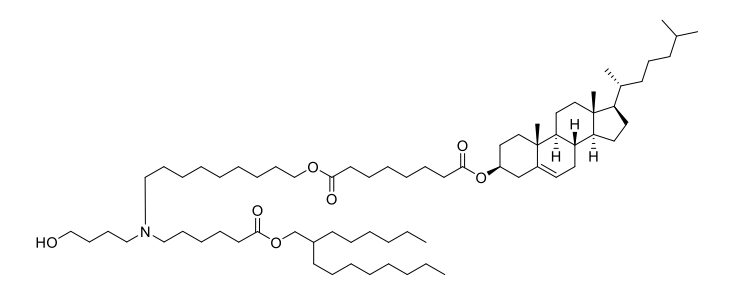
|
| DC67618 | GVS-18-B35 |
GVS-18-B35 is a leading silicon ether-based ionizable lipid that demonstrates exceptional performance in mRNA delivery. It features a biodegradable silyl ether linkage, which undergoes rapid, non-enzymatic hydrolysis, enabling near-complete clearance from the liver within 24 hours in both mice and non-human primates (NHPs). This degradation mechanism is independent of variable enzymatic activity, ensuring consistent pharmacokinetics across species. In vivo, GVS-18-B35 lipid nanoparticles (LNPs) achieve superior liver-specific protein expression with minimal off-target accumulation in the spleen, resulting in a high liver-to-spleen signal ratio and reduced immune stimulation. The LNPs exhibit excellent stability under frozen storage (-80°C) and maintain critical quality attributes, including particle size, polydispersity, and encapsulation efficiency, through multiple freeze-thaw cycles. With an optimal pKa (~6.3) and enhanced endosomal escape capability, GVS-18-B35 represents a robust and versatile platform for mRNA therapeutics, particularly suited for applications requiring frequent dosing due to its unique combination of high potency and rapid clearance profile.
More description
|
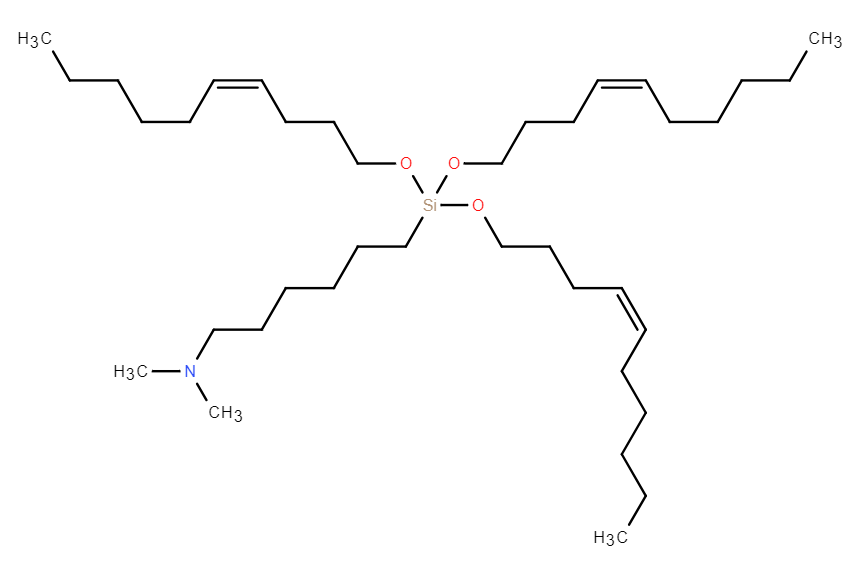
|
| DC67615 | STING Agonist Lipid SAL-12 |
SAL12 is a novel ionizable lipid derivative that integrates a non-nucleotide STING agonist (agonist 6) with an amino lipid tail through an ester bond, forming the core component of specialized lipid nanoparticles (SAL12-LNPs). These nanoparticles are designed for dual functionality: they efficiently encapsulate and deliver mRNA into dendritic cells while concurrently activating the STING pathway to stimulate innate immunity.
More description
|

|
| DC67616 | GVS-18-B34 |
GVS-18-B34 is a highly potent, silicon ether-based ionizable lipid that enables efficient mRNA delivery via lipid nanoparticles (LNPs). Its key advantage lies in a biodegradable silyl ether linkage, which undergoes rapid, non-enzymatic hydrolysis, leading to near-complete clearance from the liver within 24 hours in both mice and non-human primates (NHPs). This degradation mechanism is species-agnostic, overcoming the variability associated with esterase-dependent lipids. In vivo, GVS-18-B34 LNPs demonstrated superior liver-specific protein expression and a high liver-to-spleen signal ratio, indicating minimal off-target accumulation and reduced immune stimulation compared to benchmarks like MC3 and SM-102. The LNPs exhibited excellent stability when stored frozen at -80°C, maintaining integrity over multiple freeze-thaw cycles. With its optimal pKa (~6.3) and efficient endosomal escape profile, GVS-18-B34 represents a promising candidate for therapeutic applications requiring frequent dosing, combining high potency with a favorable safety profile derived from its rapid clearance.
More description
|
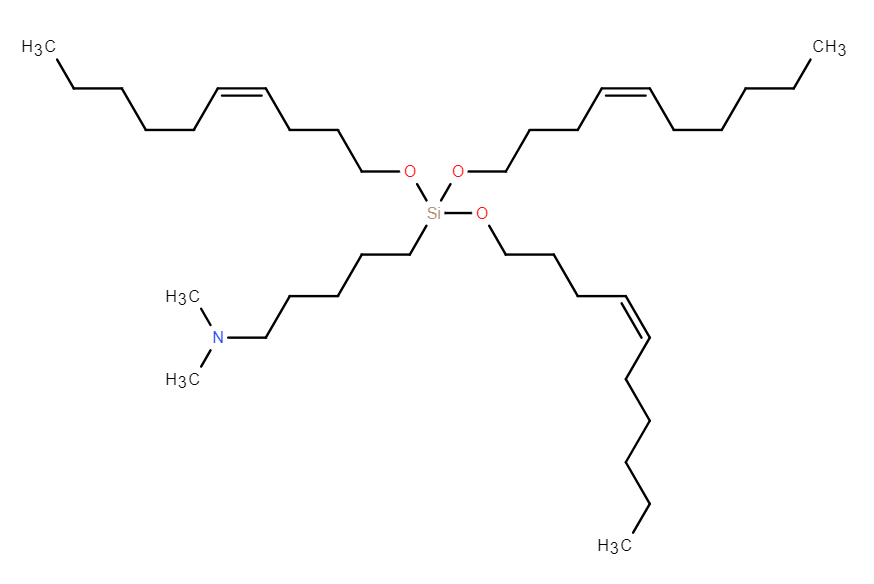
|
| DC82209 | ORNA Lipid 10a-26 Featured |
Lipid 10a-26 is an ionizable lipid developed by Orna Therapeutics for lipid nanoparticle (LNP) formulations. It features a biodegradable ester backbone and an ionizable headgroup, enabling efficient encapsulation and delivery of circular RNA (oRNA). Experimental data show that Lipid 10a-26 mediates robust protein expression in hepatocytes and immune cells (e.g., T cells), with strong liver-targeting specificity observed in vivo. Its optimized hydrolysis profile ensures stable oRNA delivery and reduced immunogenicity. For instance, LNPs formulated with Lipid 10a-26 (molar ratio 50:10:38.5:1.5) demonstrate high transfection efficiency in splenic B cells and sustained therapeutic protein production.The lipid’s design balances efficacy and safety, making it ideal for applications like CAR-T therapy and hepatic protein replacement.
More description
|
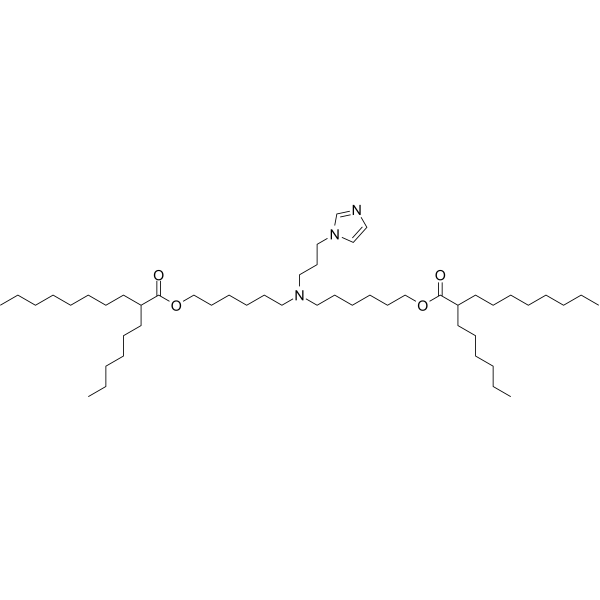
|
| DC67540 | Lipid A5-CE-C7-6 |
A5-CE-C7-6 is an ionizable lipid engineered for spleen-targeted mRNA delivery, integrating a hydroxylated dual-amine core (A5) for enhanced mRNA binding and endosomal escape, a biodegradable carbonate ester linker (CE) enabling rapid hydrolysis (61% degradation in 24 h), and branched heptyl hydrophobic tails (C7-6) that optimize nanoparticle stability and spleen tropism. When formulated into cholesterol-free lipid nanoparticles (B-8 formulation), its unique architecture—combining hydroxyl groups for cellular uptake, carbonate-mediated biodegradability, and branched-chain fluidity—achieves unprecedented efficiency: low pKa (~6.0) minimizes liver accumulation while enabling 21% transfection of splenic NK cells, outperforming benchmark systems like MC3 SORT LNPs by >10-fold in spleen-specific delivery and establishing a new standard for in vivo immune cell engineering.
More description
|
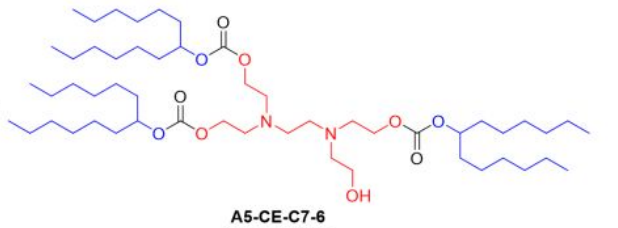
|
| DC67128 | Lipid 29 analogue-2(Lipid 16) Featured |
Lipid 29 analogue-2 is an ionizable lipid designed for the delivery of RNA-based therapeutics, such as mRNA or siRNA.
More description
|
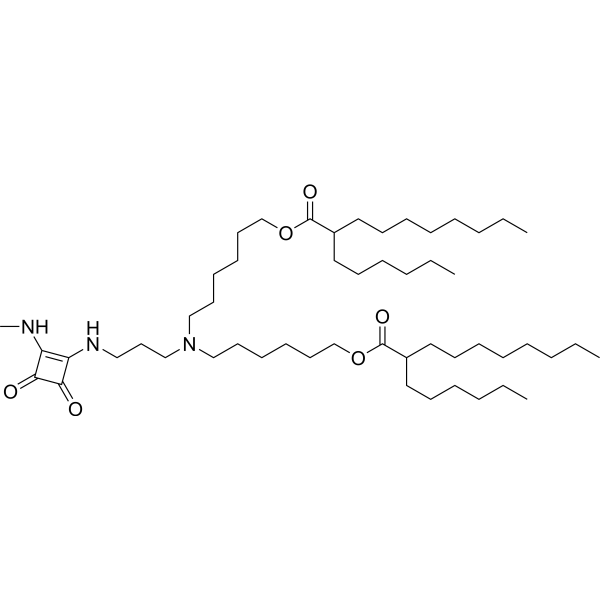
|
| DC59126 | Genevant CL1 (lipid 10) Featured |
Genevant CL1 (lipid 10) is a novel ionizable lipid for rna delivery.Lipid 10 rapidly accumulated in the liver within the first hour of dosing (reflecting LNP uptake), but levels then steadily declined over the ensuing 2 weeks period, similar to MC3.Lipid 10 afforded more than double the expression of either approved lipid. We also observed high splenic expression for ALC-0315, which correlated with higher MCP-1 levels.Animals received a single 5 µg IM dose of LNP encapsulating firefly luciferase (fLuc) mRNA. Whole body imaging was performed 6 h later and expression at the injection site quantified. Lipid 10, ALC-0315, and SM-102 showed similar expression at the injection site, all greater than the older generation benchmarks lipids (DLinDMA, KC2, MC3). Lipid 10 and ALC-0315 also showed high expression in the liver, while SM-102 was less, and more similar to MC3.Lipid 10-based LNP reported similar anti-HA IgG titers to MC3 and ALC-0315 (Comirnaty) LNP, and higher than the SM-102 (SpikeVax) LNP composition. MCP-1 levels were generally similar, although the ALC-0315 composition had a significantly higher response at the 5 µg dose. All formulations reported good stability when stored frozen at −80 °C or at 2–8 °C for 1 month.
More description
|

|
| DC67291 | ATX054 Featured |
ATX-054 which is from Arcturus RNA delivery platform, is a novel ionizable lipid used in the formulation of lipid nanoparticles (LNPs) for the delivery of RNA.
More description
|
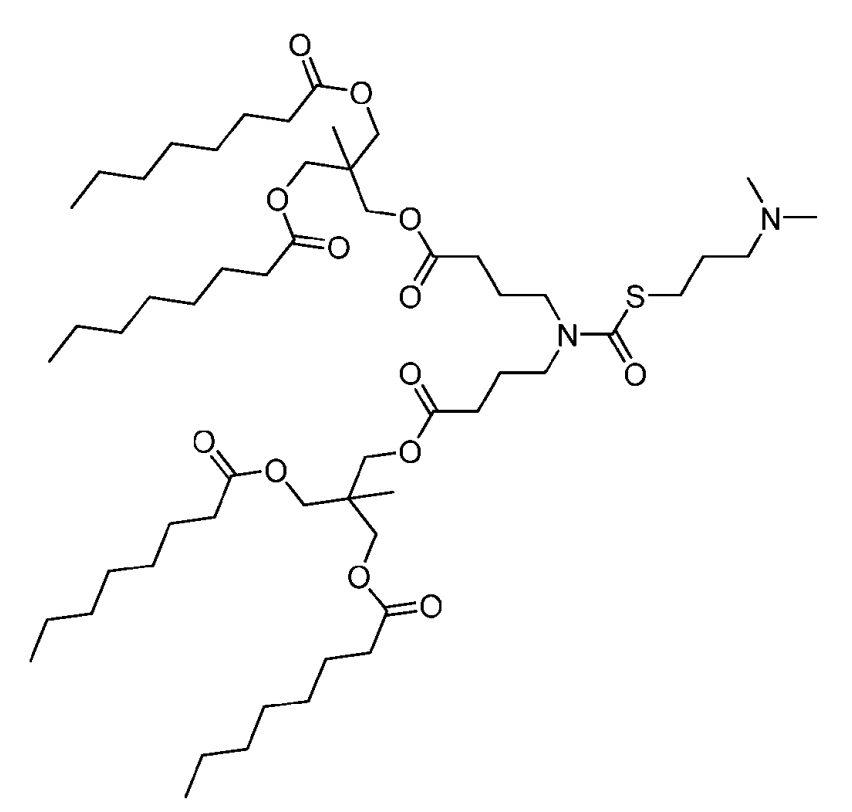
|
| DC58046 | C12-200 Featured |
C12-200 is a well-known cationic lipid used in the formulation of lipid nanoparticles (LNPs) for the delivery of therapeutic nucleic acids, including siRNA, mRNA, and CRISPR components. It is widely recognized for its high in vivo potency at low doses and is often used as a positive control ionizable lipid in research exploring new ionizable lipids.
More description
|

|
| DC31024 | SM-86 Featured |
SM86 is a cationic, ionizable lipid developed by Moderna as a core component of its lipid nanoparticle (LNP) platform for mRNA therapeutic delivery.SM-086 is structurally optimized and analogous to SM-102 (used in Moderna’s COVID-19 vaccines), with modifications aimed at enhancing mRNA delivery efficiency and safety.SM-86 serves as the primary cationic lipid in three investigational mRNA therapies targeting rare metabolic disorders:mRNA-3927: Restores propionyl-CoA carboxylase activity in propionic acidemia (PA).
mRNA-3705: Delivers methylmalonyl-CoA mutase mRNA for methylmalonic acidemia (MMA).
mRNA-3210: Provides phenylalanine hydroxylase mRNA to treat phenylketonuria (PKU).
More description
|

|
| DC31000 | LP-01 Featured |
LP-01 is an ionizable cationic amino lipid (pKa = ~6.1). It has been used in the generation of lipid nanoparticles (LNPs). LNPs containing LP-01 and encapsulating both Cas9 mRNA and modified single-guide RNA (sgRNA) for the transport protein transthyretin (Ttr) induce gene editing in liver cells in mice in a dose-dependent manner resulting in reduced serum Ttr levels for at least 12 months.
More description
|

|
| DC59217 | Arcturus lipid 2(ATX-0114) Featured |
Lipid 2,2(8,8) 4C CH3 is an ionizable cationic lipid (pKa = 6.69).1 It has been used in the generation of lipid nanoparticles (LNPs) for the delivery of siRNA in vivo. LNPs containing lipid 2,2(8,8) 4C CH3 and encapsulating siRNA targeting Factor VII decrease plasma Factor VII protein levels by 90% in mice.
More description
|

|
| DC57046 | ATX-126(ATX-0126, lipid 10p) Featured |
ATX-126(ATX-0126, 10p) is an ionizable cationic lipid (pKa = 6.38).It has been used in the generation of lipid nanoparticles (LNPs) for the delivery of siRNA. Intravenous administration of LNPs containing ATX-126(ATX-0126, 10p) and encapsulating Factor VII siRNA decrease Factor VII blood levels in mice.
More description
|

|
| DC10800 | DLin-MC3-DMA Featured |
D-Lin-MC3-DMA(MC3) is the most potent cationic lipid that has been synthesized for Lipid nanoparticles (LNPs) to deliver the siRNA.
More description
|

|
| DC60478 | ALC-0366 Featured |
ALC 0366 is an ionizable cationic lipid (pKa = 6.25) from Biontech,which is derived from ALC-0315. ALC0366 has been used as a key component of LNP to deliver BNT142, a lipid nanoparticle (LNP)-formulated RNA (RNA-LNP) encoding a T cell-engaging bispecific antibody that monovalently binds the T cell marker CD3 and bivalently binds claudin 6 (CLDN6), an oncofetal antigen that is absent from normal adult tissue but expressed on various solid tumors.
More description
|

|